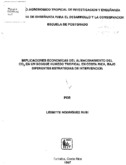Mostrar el registro sencillo del ítem
Implicaciones económicas del almacenamiento del CO2 en un bosque húmedo tropical en Costa Rica, bajo diferentes estrategias de intervención
| dc.contributor.advisor | Ramírez, Octavio | es_ES |
| dc.contributor.author | Rodríguez Rubí, Lissette E | |
| dc.date.accessioned | 2020-11-21T20:54:14Z | |
| dc.date.available | 2020-11-21T20:54:14Z | |
| dc.date.issued | 1997 | |
| dc.identifier.uri | https://repositorio.catie.ac.cr/handle/11554/10008 | |
| dc.description | Tesis (Mag Sc)--CATIE, Turrialba (Costa Rica), 1997 | es_ES |
| dc.description | 29 referencias en las páginas 65-69 | |
| dc.description | 29 referencias en las páginas 65-69 | |
| dc.description | 9 figuras. 18 tablas. | |
| dc.description | 72 páginas | |
| dc.description.abstract | El presente estudio consistió en estimar el almacenamiento de carbono en un bosque tropical muy húmedo, bajo diferentes estrategias de intervención y manejo y sus implicaciones económicas a través del tiempo. Se realizó en el bosque La Tirimbina, situado en la Zona Norte de Costa Rica. El área se encuentra bajo experimentación silvícola, en un diseño de bloques al azar con tres tratamientos, el área experimental consiste en 9 bloques de tamaño de una ha, en las cuales se ajustaron tres modelos silviculturales. El primer modelo o tratamiento uno consiste en las parcelas de bosque con aprovechamiento y sin intervención silvícola, el modelo dos consiste en el bosque con aprovechamiento y un tratamiento de dosel protector y el modelo tres el bosque con aprovechamiento y mezcla de liberación y refinamiento parcial. La estimación de carbono almacenado se realizó utilizando datos reales de árboles con un diámetro mayor o igual a 10 cm, en base a las mediciones de diámetro de 6 años de la base de datos de la Unidad de Manejo de Bosques Naturales del CATIE y en base a datos simulados de 3 aprovechamientos posteriores a partir del año 7. El análisis se realizó para un período de 60 años. Para lo cual se utilizaron ecuaciones para predecir biomasa. El método utilizado para el análisis financiero con y sin valoración de carbono es el de costo-beneficio el cual permitió determinar la rentabilidad financiera de cada uno de los tratamientos. Se utilizaron tres indicadores: el Valor Actual Neto (VAN), la Tasa Interna de Retorno (TIR) y el análisis beneficio-costo (B/C). La información fue suministrada por la Unidad de manejo de Bosques Naturales del CATIE. Se utilizaron los precios y costos unitarios de mercado del año 1997. Se encontró que la cantidad de carbono almacenado a lo largo del tiempo no mostró diferencias considerables para el tratamiento uno y para el tratamiento dos, mientras que el tratamiento tres, presentó la menor cantidad de carbono almacenado. Los resultados del análisis financiero sin la valoración de carbono indican que el tratamiento tres es el más rentable presentando el VAN más alto. Sin embargo, los resultados del análisis financiero con la valoración de carbono como un servicio ambiental indican que el tratamiento uno es el que tiene los indicadores financieros (VAN, B/C) mayores y por lo tanto es el más rentable. | es_ES |
| dc.description.abstract | The present study consisted on estimating carbon storage in a very humid tropical forest, under different interventions and management strategies and their economic implications through time. This study was carried out in a forest near a village called La Tirimbina, located in northern Costa Rica. The area is under silvicultural experimentation, on a random block design with three treatments. The experimental area consisted of 9 blocks measuring 1 hectare each, where three silvicultural models were placed. The first model or treatment one consisted of forest plots with utilization and a treatment two in the protection canopy treatment three was forest with utilization and a mixture of liberation and partial refinement. The estimation of stored carbon was done using real data from trees with a diameter equal to or more than 10 cm, according to diameter measurements made during six years from data based on the Natural Forest Management Department at CATIE, and on simulated data from 3 posterior utilizations from the seventh year. The analysis was done for a period of 60 year. For this, mathematical equations to predict biomass were used. The method used for the financial analyses with and without carbon valuation was the benefit-cost ratio, which permits to determine the financial rentability from each treatment. Three indicators were used: Net present value (NPV), Rate Internal Return (RIR) and the benefit cost analysis. Necessary information to develop the analysis was provided by the Natural Forest Management Department at CATIE, using market prices and unitary cost from year 1997. The amount of stored carbon through time didn't show considerable differences for treatments one and two, treatment three presented the smallest amount of stored carbon. The results of the financial analyses without carbon valuation indicated that treatment is the most profitable because it presented the highest NPV. However, results of the financial analyses with the carbon valuation as a environmental service indicate that the witness treatment is the one that presents the highest financial indicators (NPV, B/C) so, it is the most profitable. | |
| dc.language.iso | es | es_ES |
| dc.publisher | CATIE, Turrialba (Costa Rica) | es_ES |
| dc.subject | ANALISIS DE COSTOS Y BENEFICIOS | |
| dc.subject | BOSQUE TROPICAL HUMEDO | |
| dc.subject | COSTA RICA | |
| dc.subject | DIOXIDO DE CARBONO | |
| dc.subject | CARBON DIOXIDE | |
| dc.subject | COST BENEFIT ANALYSIS | |
| dc.subject | TROPICAL RAIN FORESTS | |
| dc.title | Implicaciones económicas del almacenamiento del CO2 en un bosque húmedo tropical en Costa Rica, bajo diferentes estrategias de intervención | es_ES |
| dc.title.alternative | Economic implications of CO2 storage on a tropical rain forest in Costa Rica, under different intervention strategies | es_ES |
| dc.type | Tesis | es_ES |
Ficheros en el ítem
Este ítem aparece en la(s) siguiente(s) colección(ones)
-
Tesis [1371]


